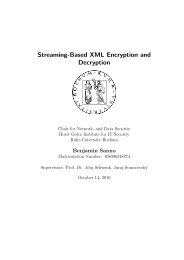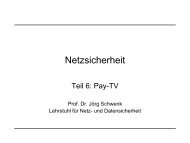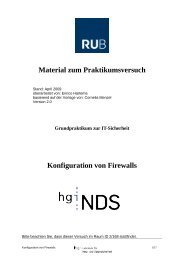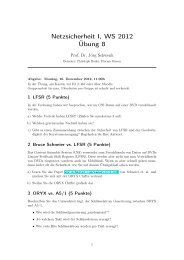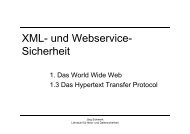Analysis and Identification of DOM Based XSS Issues
Analysis and Identification of DOM Based XSS Issues
Analysis and Identification of DOM Based XSS Issues
Create successful ePaper yourself
Turn your PDF publications into a flip-book with our unique Google optimized e-Paper software.
<strong>Analysis</strong> <strong>and</strong> <strong>Identification</strong> <strong>of</strong> <strong>DOM</strong><br />
<strong>Based</strong> <strong>XSS</strong> <strong>Issues</strong><br />
Stefano di Paola<br />
CTO @ Minded Security<br />
stefano.dipaola@mindedsecurity.com
$ whoami<br />
Stefano Di Paola @WisecWisec<br />
Research<br />
OWASP-Italy Senior Member<br />
Testing Guide Contributor<br />
OWASP SWFIntruder<br />
Bug Hunter & Sec Research<br />
(Pdf Uxss, Flash Security, HPP)<br />
Security Since '99<br />
Work<br />
CTO @ Minded Security Application Security Consulting<br />
Director <strong>of</strong> Minded Security Research Labs<br />
Lead <strong>of</strong> WAPT & Code Review Activities<br />
WebLogs: http://blog.mindedsecurity.com,<br />
http://www.wisec.it
Agenda<br />
<strong>DOM</strong> <strong>Based</strong> <strong>XSS</strong><br />
JS <strong>DOM</strong> <strong>XSS</strong> <strong>Analysis</strong> Metodology<br />
<strong>DOM</strong>inator<br />
<strong>Analysis</strong> <strong>of</strong> interesting examples<br />
Some stats
Introduction<br />
Courtesy <strong>of</strong> John Wil<strong>and</strong>er
Introduction<br />
Courtesy <strong>of</strong> John Wil<strong>and</strong>er
Introduction<br />
Courtesy <strong>of</strong> John Wil<strong>and</strong>er
Introduction<br />
Courtesy <strong>of</strong> John Wil<strong>and</strong>er
Introduction<br />
Courtesy <strong>of</strong> John Wil<strong>and</strong>er
<strong>DOM</strong> <strong>Based</strong> <strong>XSS</strong> Literature<br />
Original Paper by Amit klein in 2005<br />
http://www.webappsec.org/projects/articles/071105.shtml<br />
Outlined some basic inputs <strong>and</strong> sinks. Didn't talk about control<br />
flow<br />
Blog post by Ory Segal regarding control flow (2008)<br />
http://blog.watchfire.com/wfblog/2008/06/javascript-code.html<br />
JavaScript objects are loosely typed.<br />
If we just want to pass an existence check we can substitute an<br />
iframe window for a normal object<br />
Kuza55 <strong>and</strong> Me (2008): Attacking Rich Internet Applications<br />
(25ccc, ruxcon)
<strong>DOM</strong> <strong>Based</strong> <strong>XSS</strong> Literature Ext'd<br />
OWASP <strong>DOM</strong> <strong>Based</strong> Xss:<br />
https://www.owasp.org/index.php/<strong>DOM</strong>_<strong>Based</strong>_<strong>XSS</strong><br />
<strong>DOM</strong>Xss Wiki<br />
https://code.google.com/p/domxsswiki/wiki/Index
<strong>DOM</strong> <strong>Based</strong> <strong>XSS</strong> Twitter Example 1/4<br />
Classic Twitter URL:<br />
https://twitter.com/#!/WisecWisec<br />
Becomes:<br />
https://twitter.com/WisecWisec<br />
BUT....<br />
( function(g){<br />
var a=location.href.split("#!")[1];<br />
if(a){<br />
g.location=g.HBR=a;<br />
}<br />
}<br />
)(window);
<strong>DOM</strong> <strong>Based</strong> <strong>XSS</strong> Twitter Example 2/4<br />
http://twitter.com/#!javascript:ICanHasCookies()<br />
location=”javascript:alert(1)”<br />
Will be executed since javascript: is a pseudo-schema<br />
The first fix:<br />
(function(g){<br />
var a=location.href.split("#!")[1];<br />
if(a){<br />
g.location=g.HBR=a.replace(“:”,"",”g”);<br />
}<br />
}<br />
)(window);
<strong>DOM</strong> <strong>Based</strong> <strong>XSS</strong> Twitter Example 3/4<br />
First Bypass:<br />
Second Fix:<br />
http://twitter.com/#!javascript::Payload<br />
(function(g){<br />
var a=location.href.split("#!")[1];<br />
if(a){<br />
g.location=g.HBR=a.replace(/:/gi,"");<br />
}<br />
}<br />
)(window);
<strong>DOM</strong> <strong>Based</strong> <strong>XSS</strong> Twitter Example 4/4<br />
Second Bypass:<br />
Open Redirect: http://twitter.com/#!//www.wisec.it<br />
Js Exec on IE: http://twitter.com/#!javascript&x58;alert..<br />
Third (Final) Fix:<br />
(function(g){<br />
var a=location.href.split("#!")[1];<br />
if(a){<br />
g.location.pathname=g.HBR=a;<br />
}<br />
}<br />
)(window);
Code Flow & Terminology<br />
Sources: the input data that can be<br />
directly or indirectly controlled by an<br />
attacker.<br />
Filters: operations on Sources<br />
which change the content or check for<br />
specific structures/values.<br />
Sinks: potentially dangerous<br />
functions the can be abused to take<br />
advantage <strong>of</strong> some kind <strong>of</strong> exploitation.
Taint Propagation 1/2<br />
Sources are tainted values.<br />
Operations on a Source can result in a tainted value<br />
TR = F(S_1) Ex. TR = S_1 + P<br />
Or in a not tainted (trustworthy) value if the operation is<br />
a Well Designed Filter.<br />
R = F_wd(S_1) Ex. ??? R = ContextAwareFilter(S_1)<br />
Where Context Aware filter property depends on the<br />
Sink
Taint Propagation 2/2<br />
In order to identify a dangerous flow<br />
Taint propagation must be followed by:<br />
– Identifying Sources<br />
– Identifying Taint Operations<br />
– Identifying if a Tainted Value ends to<br />
a Sink<br />
– Identifying, according to the Sink if<br />
there's some operation that can be<br />
considered a Well Designed Filter.
Input Sources<br />
Everything taken from the URL:<br />
document.URL<br />
document.URLUnencoded<br />
document.location (.pathname|.href|.search|.hash)<br />
window.location (.pathname|.href|.search|.hash)<br />
The Referrer:<br />
document.referrer<br />
The window name:<br />
window.name
Input Sources<br />
document.cookie<br />
HTML5 postMessage arg.data<br />
window.addEventListener("message",<br />
function(msg){ eval(msg.data) }<br />
,true);<br />
window.dialogArguments<br />
(when window is opened with window.showModalDialog)
Intermediate Input Sources<br />
Sources that could have been instantiated<br />
somewhere else <strong>and</strong> retrieved on another page.<br />
Storage:<br />
localStorage/globalStorage<br />
Database<br />
HTML attributes storing user values<br />
E.g. Input.value ( Drag & Drop Abuse )<br />
Cookies<br />
XMLHTTPRequest response.
Classic Sinks<br />
Every functionality that will create HTML:<br />
innerHTML, outerHTML, document.write …<br />
Every functionality that will interpret a string as<br />
JavaScript.<br />
eval, execScript, Function, setTimeout,<br />
setInterval…<br />
but also script.src, iframe.src etc<br />
location.replace/assign
Less Classic Sinks<br />
However not all sinks must result in JavaScript<br />
execution<br />
Some additional new goals:<br />
Modify/abuse sensitive objects<br />
Modify <strong>DOM</strong>/HTML Objects<br />
Leak <strong>and</strong> insert cookies<br />
Perform directory traversal with XHR<br />
Perform CORS with XHR<br />
Client Side HPP (GUI Redressing in page)
Sinks - modify <strong>DOM</strong>/HTML Objects<br />
If we control the key:<br />
some_var = document[user_input];<br />
If we control the key <strong>and</strong> value:<br />
or<br />
window[user_input]=userInput2;<br />
config={‘url’:’http://host’, defaultX:100,defaultY:200};<br />
config[user_input]=userValue;
Sinks - Leak <strong>and</strong> insert cookies<br />
On Firefox is known that is possible to create a<br />
new Cookie using \n.<br />
document.cookie=“cookieName=”+unescape(location.hash);<br />
So #%0aANewCookie=1234<br />
document.cookie=“cookieName=#\nANewCookie=1234”;<br />
Resulting in two cookies (FF 3-4).<br />
Note: doesn't work anymore FF-7 fixed
Sinks GUI Change<br />
CSS Injection to modify the GUI/ inject Js (not<br />
alway possible)<br />
Injections into IMG tags<br />
win against Referrer check (CSRF).<br />
Let us control the UI
Css <strong>DOM</strong> Injection get sensitive values<br />
If you can inject only css, or cssText is used as sink:<br />
CSSStyleDeclaration.cssText=‘someConstant’+Source+’…’;<br />
CSS Injection to get sensitive values by inference: slow<br />
but effective.<br />
Let’s see it with a<br />
DEMO<br />
Ps. Mario Heiderich discovered a new (awesome) way<br />
http://html5sec.org/webkit/test
Css <strong>DOM</strong> Injection get sensitive values<br />
Css3 Attribute Selector<br />
http://www.w3.org/TR/css3-selectors/#attribute-selectors<br />
a[href=a] { ... }<br />
Css3 Attribute Substring Matching<br />
http://www.w3.org/TR/css3-selectors/#attribute-substrings<br />
[att^=val] :Represents an element with the att attribute whose value<br />
begins with the prefix "val".<br />
[att$=val] : Represents an element with the att attribute whose value<br />
ends with the suffix "val".<br />
[att*=val] : Represents an element with the att attribute whose value<br />
contains at least one instance <strong>of</strong> the substring "val".
HTML 5<br />
Cross Origin Request could be abused.<br />
var url=“/pr<strong>of</strong>ilePages”<br />
var xhr=new XMLHttpRequest();<br />
xhr.open(‘GET’,getQueryParam(‘debugPage’)||url,true);<br />
Facebook issue<br />
#!/pr<strong>of</strong>ileName<br />
var xhr=new XMLHttpRequest();<br />
xhr.open(‘GET’,location.hash.slice(2),true);<br />
Attacker just needs to add Access-Control-Allow-Origin: *<br />
to the response
Absolute URLs<br />
Mario Heiderich, Gareth Heyes, Sirdarkcat, Kotowicz did a<br />
very interesting research about URL parsing in browsers<br />
http://code.google.com/p/urlparsing/<br />
http://kotowicz.net/absolute/
Absolute URLs
Filters<br />
Classics<br />
(un)escape<br />
(de)encodeURIComponent<br />
(de)encodeURI<br />
It's interesting that sometimes they're not correctly used.<br />
Advanced filtering (very similar to server side filtering<br />
implementations):<br />
replace<br />
match/test
Classics Filters – Encoding Differences
Classics Filters – Decoding Differences
(Wrong) Filters - domains<br />
var urlZone=getQueryParam("zone")<br />
if(urlZone.match(/(bbc\.co\.uk)(.*)\/(.*bbc\.com)(\.js)/)){<br />
script.src=urlZone;<br />
}<br />
Do you spot the issue?
(Wrong) Filters - domains<br />
var urlZone=getQueryParam("zone")<br />
if(urlZone.match(/(bbc\.co\.uk)(.*)\/(.*bbc\.com)(\.js)/)){<br />
script.src=urlZone;<br />
}<br />
zone=http://127.0.0.1/www.bbc.co.uk/dddbbc.com.js
(Wrong) Filters – Whitelisted Tags<br />
var U = C.ns("utils"),<br />
T = //ig;<br />
U.striptags = function (g, h) {<br />
var m = k.isArray(h) ? h : null;<br />
var vv= g.replace(T, m ?<br />
function (p, w) {<br />
return m.contains(w) ? p : ""<br />
} : "“)<br />
return vv;<br />
};<br />
U.striptags( getQueryPar(‘content’), [‘b’,’i’] );<br />
do you spot the issue?
(Wrong) Filters – Whitelisted Tags<br />
var U = C.ns("utils"),<br />
T = //ig;<br />
U.striptags = function (g, h) {<br />
var m = k.isArray(h) ? h : null;<br />
var vv= g.replace(T, m ?<br />
function (p, w) {<br />
return m.contains(w) ? p : ""<br />
} : "“)<br />
return vv;<br />
};<br />
U.striptags( getQueryPar(‘content’), [‘b’,’i’] );<br />
(Wrong) Filters - Cookie<br />
Now we maybe know that \n is a metachar for FF
(Wrong) Filters – Cookie 2<br />
Several issues with cookie parsing<br />
No easy way. Lot <strong>of</strong> match/split/indexOf/substr<br />
function getCookieValue(name){<br />
var p;<br />
var c=document.cookie;<br />
var arrs=c.split(‘;’);<br />
for(var i =0 ; i< arrs.length; i++)<br />
if( (p=arrs[i].indexOf(name))>0){<br />
return arrs[i].substr(p);<br />
}<br />
}<br />
getCookieVal(“mycookieName=”)
(Wrong) Filters – Cookie 2 - Attack<br />
what if some Js writes a value like this:<br />
document.cookie=‘ref=’+document.referrer<br />
And somewhere else:<br />
eval( getCookieVal(“userHistory”) )<br />
?
(Wrong) Filters – Cookie 2 - Attack<br />
set an attacker site:<br />
http://www.attacker.com/userHist=alert(1)<br />
Iframing victim site which will sets cookie:<br />
ref=http://www.attacker.com/userHist=alert(1)<br />
Then looks for userHist <strong>and</strong> Boom!
Methodology<br />
Find the Sources using the following RegExp:<br />
/(location\s*[\[.])|([.\[]\s*["']?\s*(arguments|dialogArguments|innerHTML|<br />
write(ln)?|open(Dialog)?|showModalDialog|cookie|URL|documentURI|<br />
baseURI|referrer|name|opener|parent|top|content|self|frames)\W)|<br />
(localStorage|sessionStorage|Database)/<br />
Find the Sinks using the following RegExp:<br />
/((src|href|data|location|code|value|action)\s*["'\]]*\s*\+?\s*=)|((replace|<br />
assign|navigate|getResponseHeader|open(Dialog)?|showModalDialog|<br />
eval|evaluate|execComm<strong>and</strong>|execScript|setTimeout|<br />
setInterval)\s*["'\]]*\s*\()/<br />
(all Regexp © by Mario Heiderich)<br />
Now you get the sources & sinks <strong>and</strong> finally you can follow<br />
the flow on code like the following
Methodology (?)
Methodology<br />
Javascript is not that easy to analyze!<br />
Code can be Compressed<br />
(function (p,a,c,k,e,d){…..})()<br />
Obsfuscated<br />
c=‘’, eval(unescape("%u0540%u0556%u054C%u0519%u054E<br />
%u0550%u0557%u0518").split('' ).map(function(a)<br />
{ c+=String.fromCharCode((a.charCodeAt(0)^1337))})<br />
)<br />
Or simply sla.ckers.ed :<br />
this.__parent__.[‘l’+0x6f+’c’+0x61+’tion’]
Possible Solutions<br />
Static Analyzer:<br />
Pro: Very good at finding flows if well implemented. Very fast.<br />
Contra: the problems <strong>of</strong> every Static Analyzer KB, reflection,<br />
runtime evaluation, lot <strong>of</strong> False Positives + False Negatives etc.<br />
Script Injection to wrap sources <strong>and</strong> Sinks:<br />
Pro: use native interpreter so no problem with<br />
obfuscation/compression<br />
Contra: Cannot follow the flow.
Possible Solutions<br />
Runtime <strong>Analysis</strong> with Dynamic Tainting:<br />
Pro: Uses native interpreter so no problem with<br />
obfuscation/compression, can follow the flow.<br />
Contra: doesn’t look at alternative paths. Just propagates the taint<br />
flag. No tracking <strong>of</strong> operations. (mostly used for defense like on perl<br />
tainting or php)<br />
My Solution:<br />
<strong>DOM</strong>inator
<strong>DOM</strong>inator (<strong>DOM</strong>inatriXss)<br />
<strong>DOM</strong>inator is a tool for analyzing <strong>and</strong> identifying<br />
<strong>DOM</strong> Xss.<br />
Modified version <strong>of</strong> SpiderMonkey (JS Engine) to<br />
add Dynamic Tainting <strong>and</strong> perform Taint propagation<br />
Tracing.<br />
Modified version <strong>of</strong> Firefox to add taint<br />
propagation to <strong>DOM</strong> Attributes <strong>and</strong> chrome methods.<br />
Extension for Log Monitoring <strong>and</strong> runtime analysis.
<strong>DOM</strong>inator Architecture
<strong>DOM</strong>inator Interface
<strong>DOM</strong>inator In Action
Demo Time
Some Stats<br />
Took first 100 from Top 1 Million Alexa list.<br />
Found several others in top 1 Million most <strong>of</strong> them<br />
advertising hosted as 3rd party scripts.<br />
For example Omniture, Google AdWords, or widgets, buttons<br />
etc.<br />
Using <strong>DOM</strong>inator + my brain I found that<br />
56 out <strong>of</strong> 100 top Alexa sites<br />
where vulnerable to directly exploitable <strong>DOM</strong> <strong>Based</strong> Xss.<br />
Means, remote attacker with a reliable scenario.
<strong>DOM</strong>inator Community Version<br />
google code project:<br />
http://code.google.com/p/dominator/downloads/list<br />
Working on porting it to Firefox 7+<br />
Mailing List:<br />
http://groups.google.com/group/dominator-ml/
Tnx!<br />
^_^<br />
Go <strong>and</strong> exploit<br />
/* ethically */<br />
Q&A<br />
Mail:<br />
stefano.dipaola@mindedsecurity.com<br />
Twitter: wisecwisec





